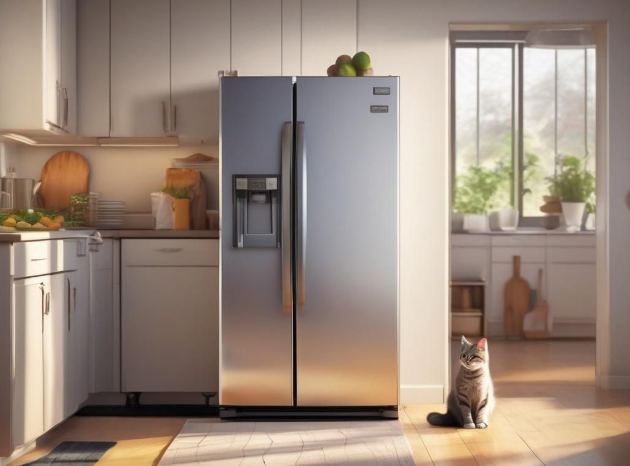If you have bought a new fridge, you might be looking for the answer: How long does it take to get cold? This is entirely normal because we often don’t know about fridge temperature.
When I bought my first fridge for my new house, the company told me to let it cool overnight before putting anything inside. At that time, I learned that it takes around 12 hours to cool down.
However, this information wasn’t entirely accurate, as I found that different people have different opinions regarding the time it takes to reach the right temperature.
Well, don’t worry! In this article, I will tell you how long a fridge takes to cool down and what factors it depends on.
Contents
- 1 Which Factors Affect Refrigerator Cooling Time?
- 2 Cooling Times for Different Types of Refrigerators
- 3 How To Know Refrigerator Is at the Right Temperature to Preserve Food
- 4 People Wrongly Think About Fridge Cooling
- 5 How to Maintain the Proper temperature in Your Fridge
- 6 Warm Temperatures are Necessary to Watch Out
- 7 Related Quick FAQs
- 8 Final Takeaway
Which Factors Affect Refrigerator Cooling Time?
- Size: First of all, consider the size of the fridge. If the refrigerator is larger, cooling down will take longer. This is quite a logical point. Mini fridges usually cool within 5 hours, whereas a large fridge can take a whole day to cool down.
- From Where the Fridge Comes: A main factor is where the fridge comes from. If it comes from an area with higher temperatures, like a warm environment, it might take up to 40°F to cool down.
- Room Temperature: I always say that if the kitchen is small, never place fridges there. A new fridge in an area where air doesn’t circulate will not cool down quickly.
Additionally, putting it in such places increases the chances of the fridge breaking down. Food stored inside the refrigerator can spoil. Always keep the fridge near a window area.
- Empty vs. stocked: When a fridge is filled with food items, there is less space for the warm air to circulate, and it is easier for a fridge to keep the temperature low. But when it is time for the first cooling down, nothing should be placed inside the fridge.
- How often do you open the door? Close the door during the cooling phase as well. This is because when one opens the door, it brings in hot air into the room, and at the same time, it lets out the cold air, meaning that the cooling process takes time.
Cooling Times for Different Types of Refrigerators
- Mini Fridges
These small units cool pretty quickly, in around 4 to 6 hours. They’re ideal for rapid cooling in small spaces.
- Top-Freezer Fridges
These common models take 4 to 24 hours to reach a fully chilled state. Exactly how long it takes will depend on the brand and how warm your room is.
- Bottom Freezer Fridges
Just like top freezers, these will take 2 to 24 hours to be at the correct temperature. Again, the length of time varies with the size of the fridge and who manufactures it.
- Door Fridges
These fancy fridges also take 2 to 24 hours to chill down. Sometimes their special design allows them to cool down faster because air moves around better inside.
- Side-by-Side Fridges
These types usually take 2 to 24 hours to get cold. Sometimes they might take longer than other types because the air doesn’t flow quite as well with the split design.
Note: For all these times, the exact cooling speed depends upon things like how warm your kitchen is, how big the fridge is, and what features it has.
How To Know Refrigerator Is at the Right Temperature to Preserve Food
The FDA advises that the inside temperature of refrigerator storage should be maintained at 40°F and below.
Some refrigerator models feature an interface that displays temperature readings on at least one digital display.
It is important to have a thermometer not only at the time of installation and the first stage of cooling but also because temperature changes indicate something is wrong with your refrigerator. Regularly checking the temperature inside your fridge is essential for ensuring food safety and freshness.
People Wrongly Think About Fridge Cooling
- Cold Water Cools Things Down Faster in the Fridge
Pouring cold water into the fridge helps cool it down quicker. However, adding any liquid can raise the fridge’s internal temperature instead of lowering it.
- A Full Fridge Uses Less Energy
A full fridge would stay cold better and save energy, but that’s not the case. A refrigerator that is packed too tightly can restrict air circulation, leading to uneven cooling and potentially spoiling your food.
How to Maintain the Proper temperature in Your Fridge
Your refrigerator has to be maintained at 40°F (4°C) or below to safely store your food. This cold temperature reduces the growth rate of bad germs on your food, meaning that your food will last longer. Here’s how to make sure your fridge is cold enough:
Using a Fridge Thermometer
The simplest method of determining the fridge’s efficiency involves using a thermometer. These are designed specifically for inspecting refrigerators and freezers.
Place it near the door, for instance, because we know that area is usually the hottest.
Wait a little, then ensure the bottom part reads 40°F (4°C) or lower.
Check Often
- You need to monitor the temperature to make sure your fridge is always cold.
- Carry out this task at least twice a day, or more often if you think your refrigerator is not working properly.
- Make sure you write down the temperatures you see; if you do not do this, you will not notice when there are issues with the temperature.
Warm Temperatures are Necessary to Watch Out
Food should never be left above 41°F (5°C) because it could make you ill. Food needs to always be at a specific temperature so as not to let germs grow fast when the food is too warm. If your fridge temperature rises for a long time, discard these items, including milk, meat, and leftovers.
Fixing Temperature Problems
If your refrigerator is not cold enough, you may need to adjust several parameters.
There is a dial or buttons that show or allow you to adjust the level of coldness of the fridges. After changing it, it’s advisable to wait until the next day before verifying status again.
Related Quick FAQs
How Much Time Does a New Refrigerator Need to Cool Down?
A brand-new refrigerator typically takes 4 to 24 hours to reach its optimal cooling temperature. While some samples cool faster, it’s best to allow a full day for your device to be ready to preserve your food at its freshest!
How Long Does It Take for a Refrigerator to Cool Down After a Power Outage?
After a power outage, a refrigerator typically takes about 4 hours to return to its ideal cooling temperature. Keep the doors closed during this time to speed up the process and maintain food freshness!
How Can I Help My Refrigerator Cool Down Faster?
To speed up your refrigerator’s cooling process, place it in a cool, well-ventilated spot, avoid overfilling it with food, and temporarily set the thermostat to its coldest setting for more immediate results.
Why Isn’t My Fridge Cold?
If your fridge isn’t cooling correctly, dirty condenser coils are often the offender. When dust and lint build up on the coils (located at the back or bottom of the appliance), they trap heat, preventing the fridge from maintaining a cold temperature. Cleaning the coils can help your fridge regain its cooling power!
Can You Use a New Refrigerator Immediately?
You can start using a new refrigerator immediately, but there are a few key steps. Provide the compressor functions correctly and check that the freezer has reached a cold temperature before reserving it with food.
Final Takeaway
The time taken to cool refrigerators is approximately 12 hours on average. However, the cooling time ranges from 2 hours to 24 hours, based on the brand of the device. The number of recommended fans for your fridge depends on the appliance’s installation manual.
The last and most important rule or, arguably, the worst thing you should never do is put food in the fridge that hasn’t been cooled to 40°F yet.
To help cool faster, switch on the A.C., and ensure the fridge is not close to the wall, say a few inches away. Most importantly, be patient and lock the door.

